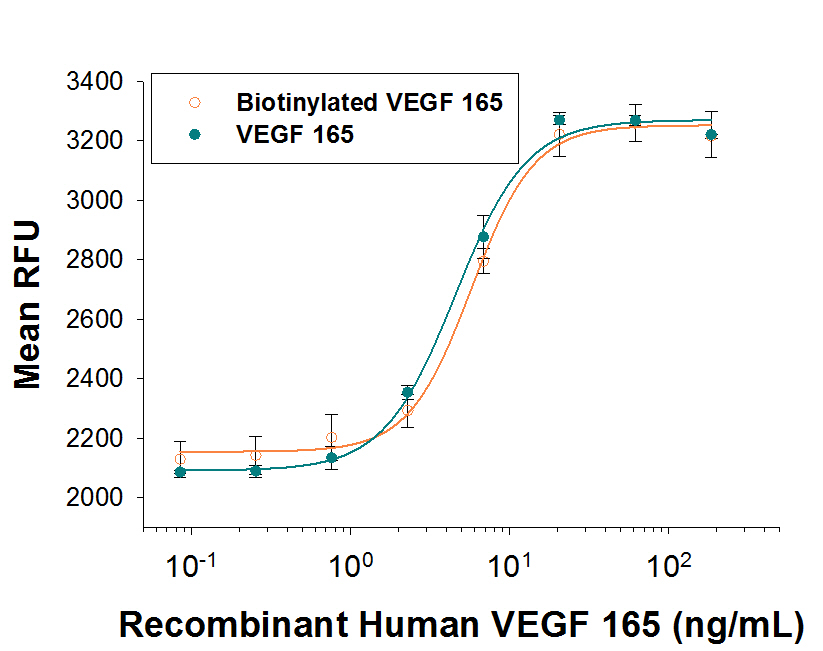Recombinant Human VEGF 165, Biotinylated Protein Summary
Product Specifications
Product Datasheets
BT293/CF (carrier free)
Discontinued Product
BT293
| Formulation | Lyophilized from a 0.2 μm filtered solution in Acetonitrile and TFA with BSA as a carrier protein. |
| Reconstitution | Reconstitute at 100 μg/mL in 4 mM HCl. |
| Shipping | The product is shipped at ambient temperature. Upon receipt, store it immediately at the temperature recommended below. |
| Stability & Storage: | Use a manual defrost freezer and avoid repeated freeze-thaw cycles.
|
Scientific Data
 View Larger
View Larger
Both Biotinylated Recombinant Human VEGF 165 (Catalog # BT293) and unlabeled Recombinant Human VEGF 165 (Catalog # 293-VE) stimulate HUVEC human umbilical vein endothelial cell proliferation. The ED50 for this effect is 1-6 ng/mL. The similarity in activity highlights that the biotinylated protein is fully functional.
Reconstitution Calculator
Background: VEGF
Vascular endothelial growth factor (VEGF or VEGF-A), also known as vascular permeability factor (VPF), is a potent mediator of both angiogenesis and vasculogenesis in the fetus and adult (1, 2). It is a member of the PDGF family that is characterized by the presence of eight conserved cysteine residues and a cystine knot structure (3). Humans express two sets of alternatively spliced isoforms of 121, 145, 165, 183, 189, and 206 amino acids (aa) in length (3, 4). Isoforms other than VEGF 121 contain basic heparin-binding regions and are not freely diffusible (3, 4). VEGF 165 appears to be the most abundant and potent of the angiogenic isoform set, followed by VEGF 121 and VEGF 189 (3, 5). The anti-angiogenic or “b” set of isoforms is differentially spliced to contain five alternative amino acids at the C-terminus, and are the more highly expressed isoforms in normal adult tissue (6). VEGF 165b like VEGF 121 but unlike most angiogenic isoforms, does not bind heparins and is therefore diffusible (3). Human VEGF 165 shares 88% aa sequence identity with corresponding regions of mouse and rat, 96% with porcine, 95% with canine, and 93% with feline, equine and bovine VEGF 165 respectively. In addition to alternatively spliced VEGF isoforms, multiple fragments of VEGF can be generated by extracellular proteolysis (4). VEGFs bind the type I transmembrane receptor tyrosine kinases VEGF R1 (also called Flt-1) and VEGF R2 (Flk-1/KDR) on endothelial cells (3). Although VEGF affinity is highest for binding to VEGF R1, VEGF R2 appears to be the primary mediator of VEGF angiogenic activity (3, 5). VEGF 165 binds the semaphorin receptor, Neuropilin-1 and promotes complex formation with VEGF R2 (7). VEGF is required during embryogenesis to regulate the proliferation, migration, and survival of endothelial cells (3, 5). In adults, VEGF functions mainly in wound healing and the female reproductive cycle (5). Pathologically, it is involved in tumor development and tumor vascular leakage (8). Circulating VEGF levels correlate with disease activity in autoimmune diseases such as rheumatoid arthritis, multiple sclerosis, and systemic lupus erythematosus (9). VEGF is induced by hypoxia and cytokines such as IL-1, IL-6, IL-8, Oncostatin M, and TNF-alpha (5, 10).
- Leung, D.W. et al. (1989) Science 246:1306.
- Keck, P.J. et al. (1989) Science 246:1309.
- Robinson, C.J. and S.E. Stringer (2001) J. Cell. Sci. 114:853.
- Vempati, P. et al. (2014) Cytokine Growth Factor Rev. 25:1.
- Byrne, A.M. et al. (2005) J. Cell. Mol. Med. 9:777.
- Nowak, D.G. et al. (2008) J. Cell Sci. 121:3487.
- Pan, Q. et al. (2007) J. Biol. Chem. 282:24049.
- Goel, H.L. and A.M. Mercurio (2013) Nat. Rev. Cancer 13:871.
- Carvalho, J.F. et al. (2007) J. Clin. Immunol. 27:246.
- Angelo, L.S. and R. Kurzrock (2007) Clin. Cancer Res. 13:2825.
Citations for Recombinant Human VEGF 165, Biotinylated Protein
R&D Systems personnel manually curate a database that contains references using R&D Systems products. The data collected includes not only links to publications in PubMed, but also provides information about sample types, species, and experimental conditions.
3
Citations: Showing 1 - 3
Filter your results:
Filter by:
-
Islet vascularization is regulated by primary endothelial cilia via VEGF-A-dependent signaling
Authors: Y Xiong, MJ Scerbo, A Seelig, F Volta, N O'Brien, A Dicker, D Padula, H Lickert, JM Gerdes, PO Berggren
Elife, 2020-11-17;9(0):.
Species: Human
Sample Types: Whole Cells
Applications: Cell Culture -
Disrupting VEGF-VEGFR1 Interaction: De Novo Designed Linear Helical Peptides to Mimic the VEGF13-25 Fragment
Authors: B Balsera, MÁ Bonache, M Reille-Ser, N Gagey-Eils, M Vidal, R González-M, MJ Pérez de V
Molecules, 2017-10-28;22(11):.
Species: Human
Sample Types: Recombinant Protein
Applications: Binding Assay -
DSGOST inhibits tumor growth by blocking VEGF/VEGFR2-activated angiogenesis
Oncotarget, 2016-04-19;7(16):21775-85.
Applications: Bioassay
FAQs
No product specific FAQs exist for this product, however you may
View all Proteins and Enzyme FAQsReviews for Recombinant Human VEGF 165, Biotinylated Protein
Average Rating: 5 (Based on 1 Review)
Have you used Recombinant Human VEGF 165, Biotinylated Protein?
Submit a review and receive an Amazon gift card.
$25/€18/£15/$25CAN/¥75 Yuan/¥2500 Yen for a review with an image
$10/€7/£6/$10 CAD/¥70 Yuan/¥1110 Yen for a review without an image
Filter by:




